coolant level CHEVROLET TRACKER 1998 1.G Owners Manual
[x] Cancel search | Manufacturer: CHEVROLET, Model Year: 1998, Model line: TRACKER, Model: CHEVROLET TRACKER 1998 1.GPages: 386, PDF Size: 21.17 MB
Page 216 of 386
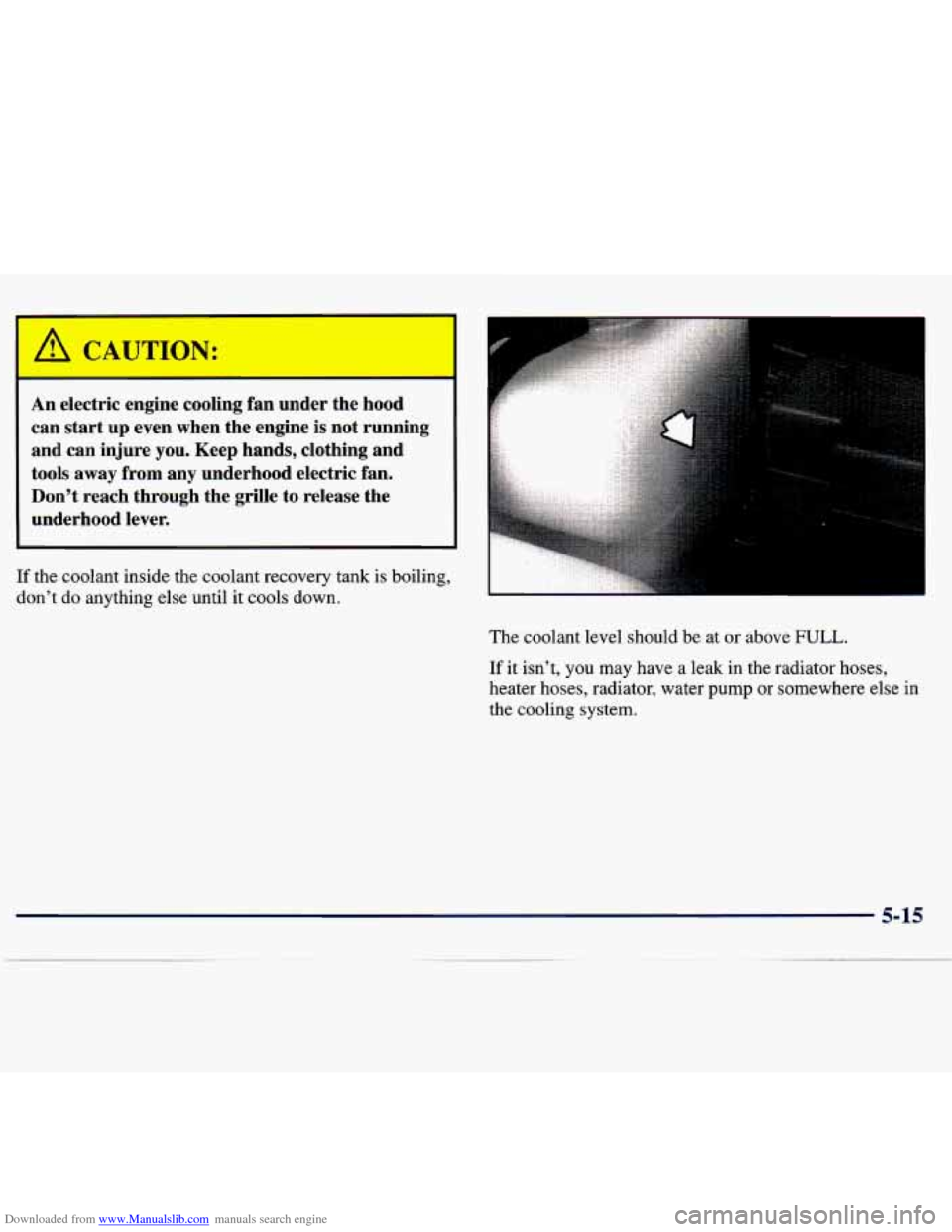
Downloaded from www.Manualslib.com manuals search engine I
An electric engine cooling fan under the hood
can start
up even when the engine is not running
and can injure
you. Keep hands, clothing and
tools away from any underhood electric fan.
Don’t reach through the grille
to release the
underhood lever.
If the coolant inside the coolant recovery tank is boiling,
don’t
do anything else until it cools down.
The coolant level should be at
or above FULL.
If it isn’t, you may have a leak in the radiator hoses,
heater hoses, radiator, water pump or somewhere else in
the cooling system.
5-15
Page 217 of 386

Downloaded from www.Manualslib.com manuals search engine I A
A C ,U ION:
Heater and radiator hoses, and other engine
parts, can be
very hot. Don’t touch them. If you
do, you can be burned.
Don’t run the engine if there is
a leak. If you run
the engine, it could lose all coolant. That could
cause an engine fire, and you could be burned.
Get
any leak fixed before you drive the vehicle.
NOTICE:
Engine damage from running your engine
without coolant isn’t covered by your warranty.
If there seems to be no leak, with the engine on, check to
see if the electric engine cooling fan
is running. If the
engine is overheating, the fan should be running. If it
isn’t, your vehicle needs service.
How to Add Coolant to the Coolant
Recovery Tank
If you haven’t found a problem yet, but the coolant
level isn’t at or above the
FULL mark, add a 50/50
mixture of clean water (preferably distilled) and a
proper coolant at the coolant recovery tank. (See
“Engine Coolant” in the Index for more information
about
the proper coolant mixture.)
Adding only plain water
to your cooling system
can be dangerous. Plain water, or
some other
liquid like alcohol, can boil before the proper
coolant mixture will. Your vehicle’s coolant
warning system is set for the proper coolant
mixture. With plain water or the wrong mixture,
your engine could get too hot but you wouldn’t
get the overheat warning. Your engine could
catch fire and you or others could be burned.
Use a 50/50 mixture of clean water and a
proper coolant.
5-16
Page 221 of 386
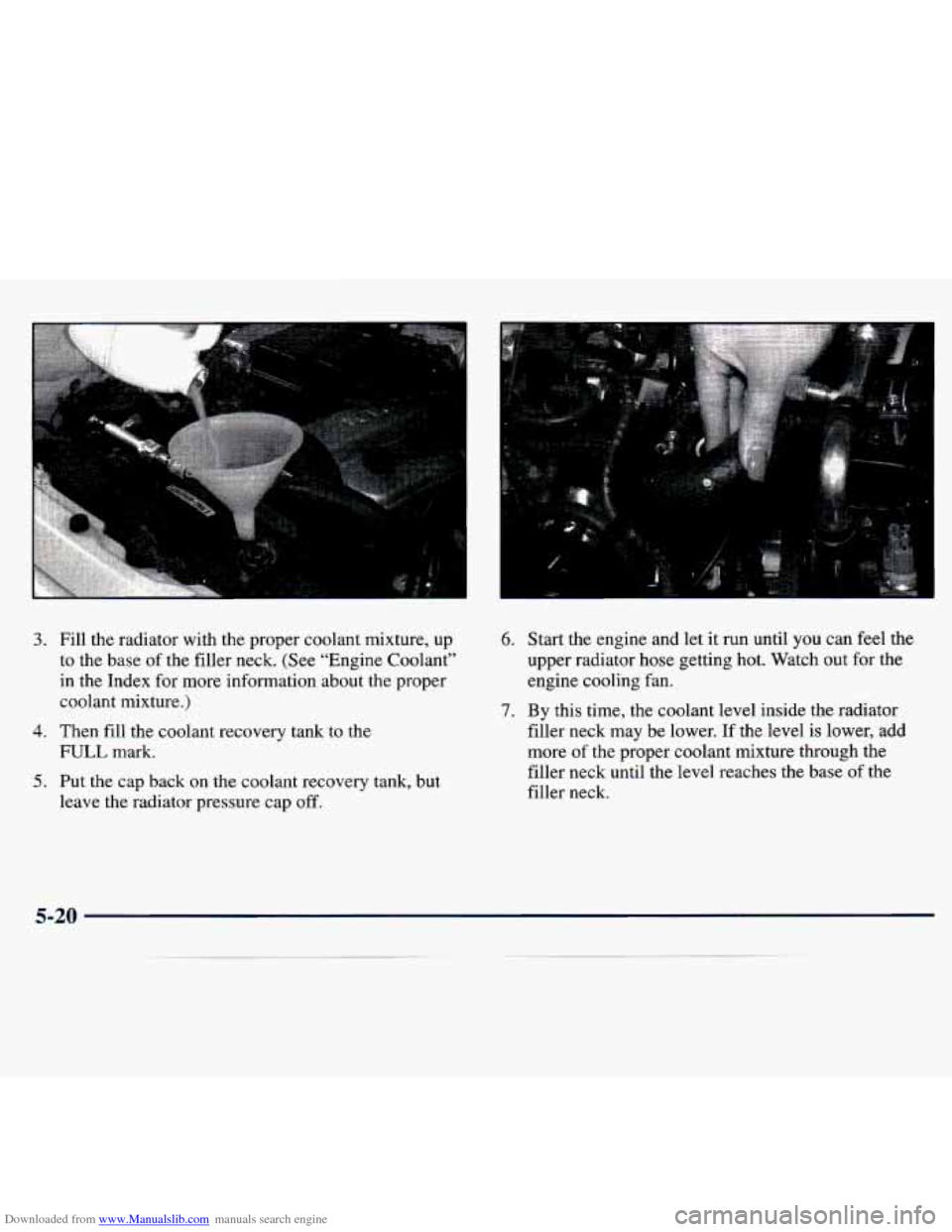
Downloaded from www.Manualslib.com manuals search engine 3. Fill the radiator with the proper coolant mixture, up
to the base of the filler neck. (See “Engine Coolant” in the Index for more information about the proper
coolant mixture.)
4. Then fill the coolant recovery tank to the
FULL mark.
5. Put the cap back on the coolant recovery tank, but
leave the radiator pressure cap off.
6. Start the engine and let it run until you can feel the
upper radiator hose getting hot. Watch out for the
engine cooling fan.
7. By this time, the coolant level inside the radiator
filler neck may be lower. If the level is lower, add
more of the proper coolant mixture through the
filler neck until the level reaches the base
of the
filler neck.
5-20
Page 238 of 386
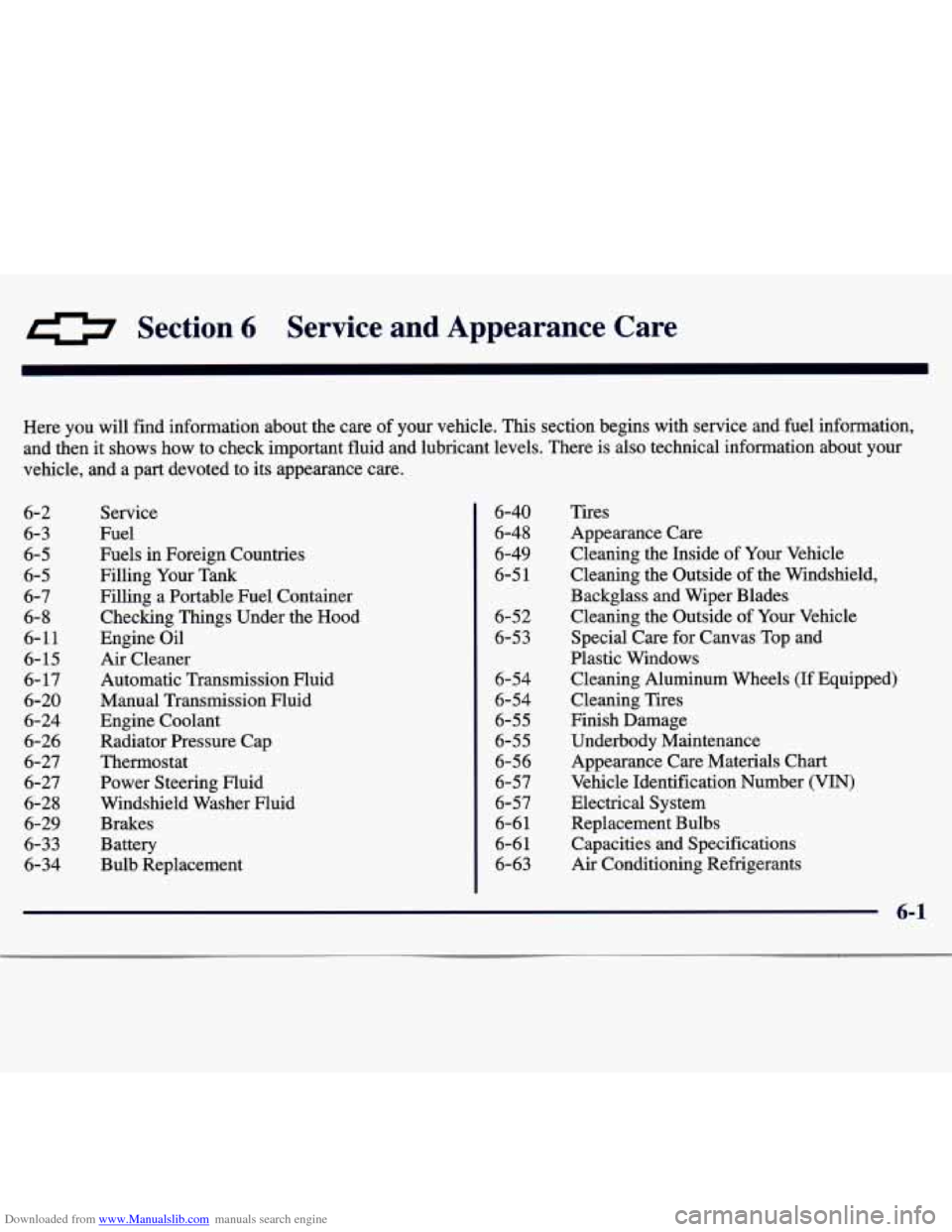
Downloaded from www.Manualslib.com manuals search engine 0 Section 6 Service and Appearance Care
Here you will find information about the care of your vehicle. This section begins with service and fuel information,
and then it shows how to check important fluid and lubricant levels. There is also technical i\
nformation about your
vehicle, and a part devoted to its appearance care.
6-2
6-3
6-5
6-5
6-7
6- 8 6-11
6-15
6-17
6-20
6-24
6-26
6-27
6-27
6-28
6-29
6-33
6-34 Service
Fuel
Fuels in Foreign Countries
Filling Your Tank
Filling a Portable Fuel Container
Checking Things Under the Hood
Engine Oil
Air Cleaner
Automatic Transmission Fluid
Manual Transmission Fluid
Engine Coolant
Radiator Pressure Cap
Thermostat
Power Steering Fluid
Windshield Washer Fluid Brakes
Battery
Bulb Replacement 6-40
6-48
6-49
6-5
1
6-52
6-53
6-54
6-54
6-55
6-55
6-56 6-57
6-57
6-61
6-6
1
6-63 Tires
Appearance Care Cleaning the Inside of Your Vehicle
Cleaning the Outside
of the Windshield,
Backglass and Wiper Blades
Cleaning the Outside of Your Vehicle
Special Care for Canvas Top and
Plastic Windows
Cleaning Aluminum Wheels
(If Equipped)
Cleaning Tires
Finish Damage
Underbody Maintenance
Appearance Care Materials Chart
Vehicle Identification Number (VIN)
Electrical System Replacement Bulbs
Capacities and Specifications
Air Conditioning Refrigerants
6-1
Page 261 of 386
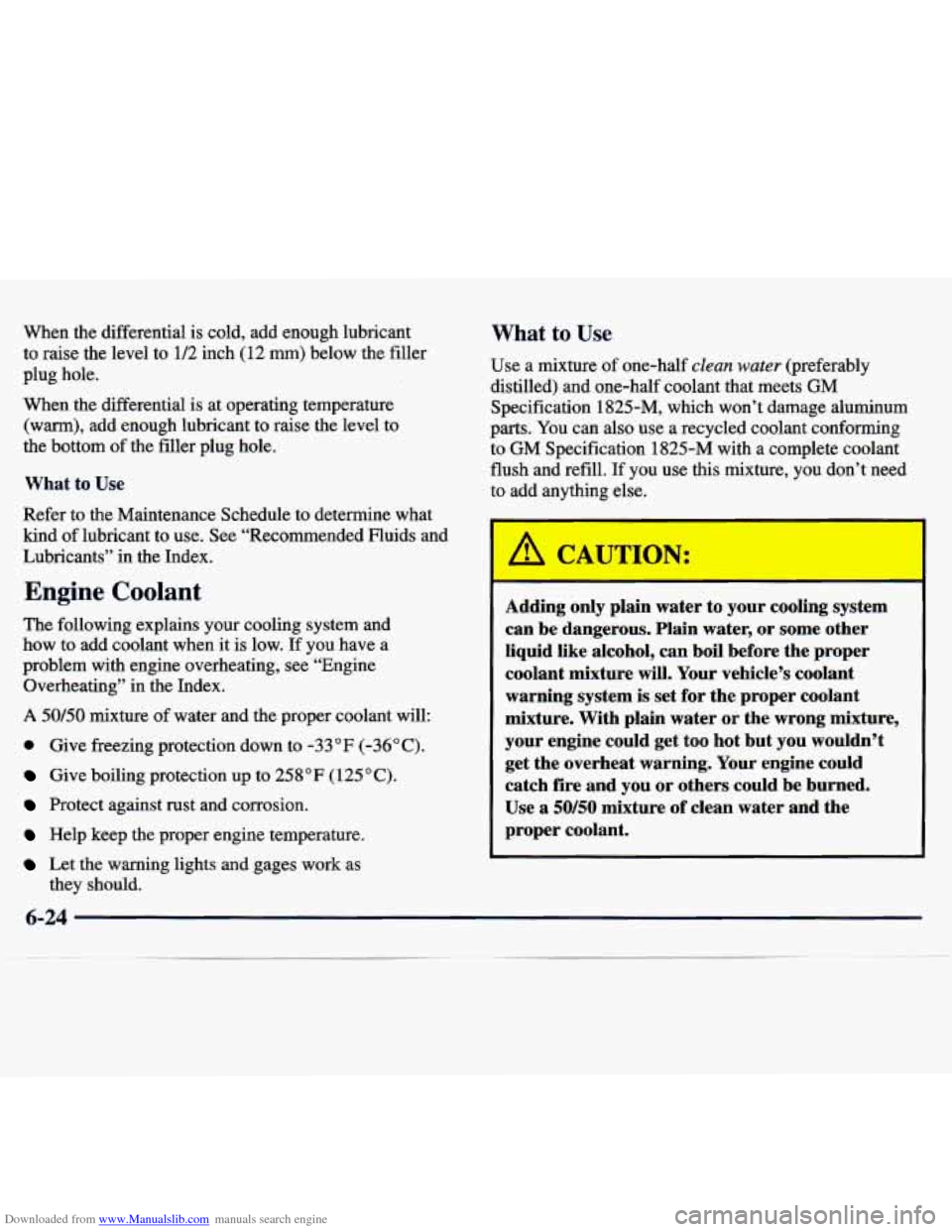
Downloaded from www.Manualslib.com manuals search engine When the differential is cold, add enough lubricant
to raise the level to 1/2 inch (12
mm) below the filler
plug hole.
When the differential is at operating temperature
(warm), add enough lubricant to raise the level to
the bottom
of the filler plug hole.
What to Use
Refer to the Maintenance Schedule to determine what
kind of lubricant to use. See “Recommended Fluids and
Lubricants” in the Index.
Engine Coolant
The following explains your cooling system and
how to add coolant when it is low. If you have a
problem with engine overheating, see “Engine
Overheating” in the Index.
A 50/50 mixture of water and the proper coolant will:
0 Give freezing protection down to -33°F (-36°C).
Give boiling protection up to 258 OF (1 25 O C).
Protect against rust and corrosion.
Help keep the proper engine temperature.
Let the warning lights and gages work as
they should.
What to Use
Use a mixture of one-half clean water (preferably
distilled) and one-half coolant that meets GM
Specification 1825-M, which won’t damage aluminum
parts.
You can also use a recycled coolant conforming
to GM Specification 1825-M with a complete coolant
flush and refill.
If you use this mixture, you don’t need
to add anything else.
Adding only plain water
to your cooling system
can be dangerous. Plain water, or some other
liquid like alcohol, can boil before the proper
coolant mixture will. Your vehicle’s coolant
warning system
is set for the proper coolant
mixture. With plain water or the wrong mixture,
your engine could get
too hot but you wouldn’t
get the overheat warning. Your engine could
catch fire and you or others could be burned.
Use a
50/50 mixture of clean water and the
proper coolant.
Page 262 of 386

Downloaded from www.Manualslib.com manuals search engine NOTICE:
If you use an improper coolant mixture, your
engine could overheat and be badly damaged.
The repair
cost wouldn’t be covered by your
warranty.
Too much water in the mixture can
freeze and crack the engine, radiator, heater core
and other parts.
If you have to add coolant more than four times
a year,
have your dealer check your cooling system.
I NOTICE:
If you use the proper coolant, you don’t have to
add extra inhibitors or additives which claim to
improve the system. These can be harmful.
Checking Coolant
When your engine is cold, the coolant level should be at
LOW, or a little higher. When your engine
is warm, the
level should be up to FULL, or
a little higher.
Adding Coolant
If you need more coolant, add the proper coolant
mixture
at the coolant recovery tank.
Page 264 of 386

Downloaded from www.Manualslib.com manuals search engine When you replace your radiator pressure cap, an AC@
cap is recommended.
Thermostat
Engine coolant temperature is controlled by a thermostat
in the engine coolant system. The thermostat stops the
flow of coolant through the radiator until the coolant
reaches a preset temperature.
When you replace your thermostat, an AC' thermostat
is recommended.
Power Steering Fluid
When to Check Power Steering Fluid
It is not necessary to regularly check power steering
fluid unless you suspect there is a leak in the system
or
you hear an unusual noise. A fluid loss in this system
could indicate a problem. Have the system inspected
and repaired.
How To Check Power Steering Fluid
When the engine compartment is cool, wipe the cap and the top
of the reservoir clean, then unscrew the cap and
wipe the dipstick with a clean rag. Replace the cap and
completely tighten it. Then remove the cap again and
look at the fluid level on the dipstick.
When the engine compartment is hot,
the level should
be at the MAX mark.
6-27
.
Page 266 of 386
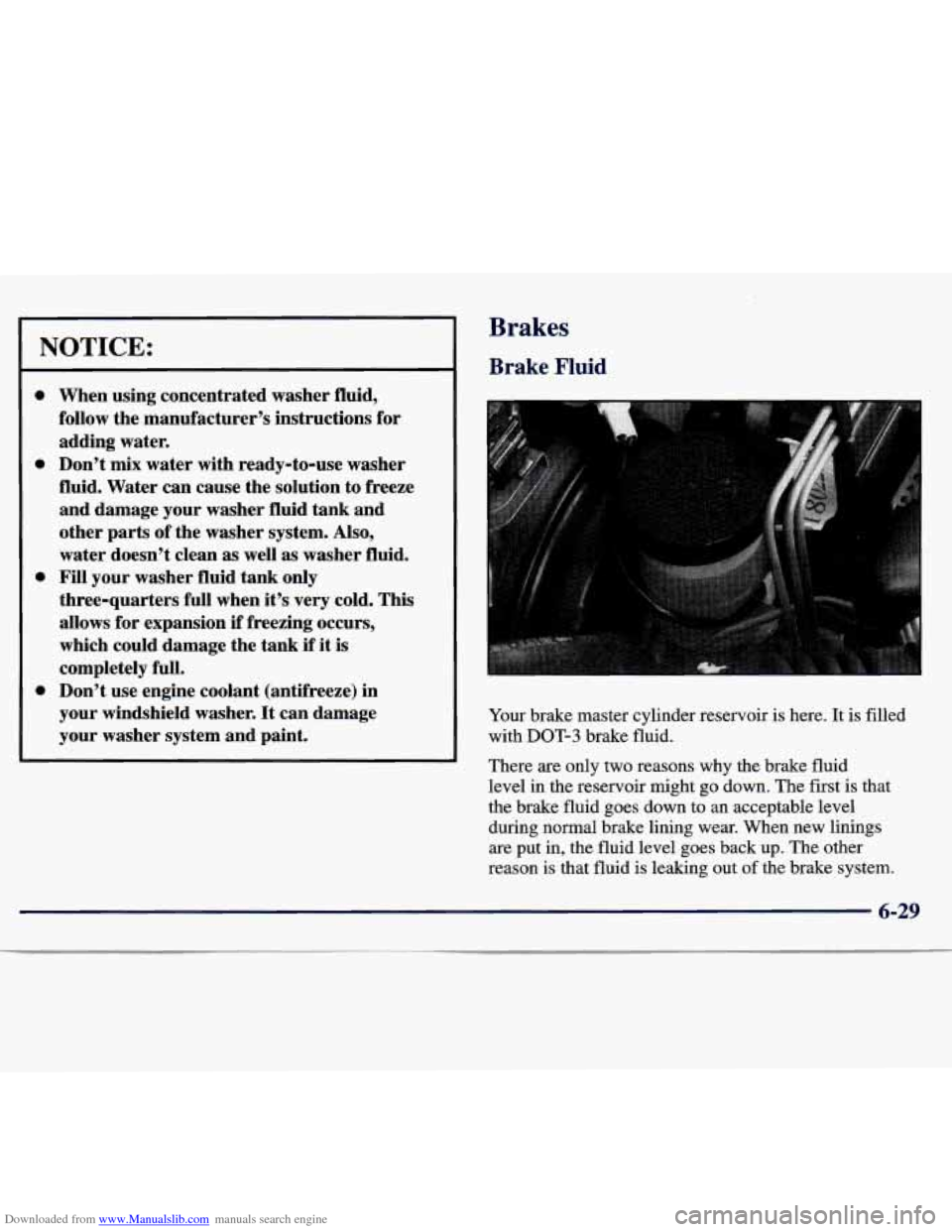
Downloaded from www.Manualslib.com manuals search engine NOTICE:
0
0
0
0
When using concentrated washer fluid,
follow the manufacturer’s instructions for
adding water.
Don’t mix water with ready-to-use wasner
fluid. Water can cause the solution to freeze and damage your washer fluid tank and
other parts of the washer system. Also,
water doesn’t clean
as well as washer fluid.
Fill your washer fluid tank only
three-quarters full when it’s very cold. This
allows for expansion
if freezing occurs,
which could damage the tank if it is
completely
full.
Don’t use engine coolant (antifreeze) in
your windshield washer. It can damage
your washer system and paint.
Brakes
Brake Fluid
Your brake master cylinder reservoir is here. It is filled
with DOT-3 brake fluid.
There are only two reasons why the brake fluid
level in the reservoir might go down. The first is that
the brake fluid goes down to an acceptable level
during normal brake lining wear. When new linings
are put in, the fluid level goes back up. The other
reason
is that fluid is leaking out of the brake system.
Page 350 of 386
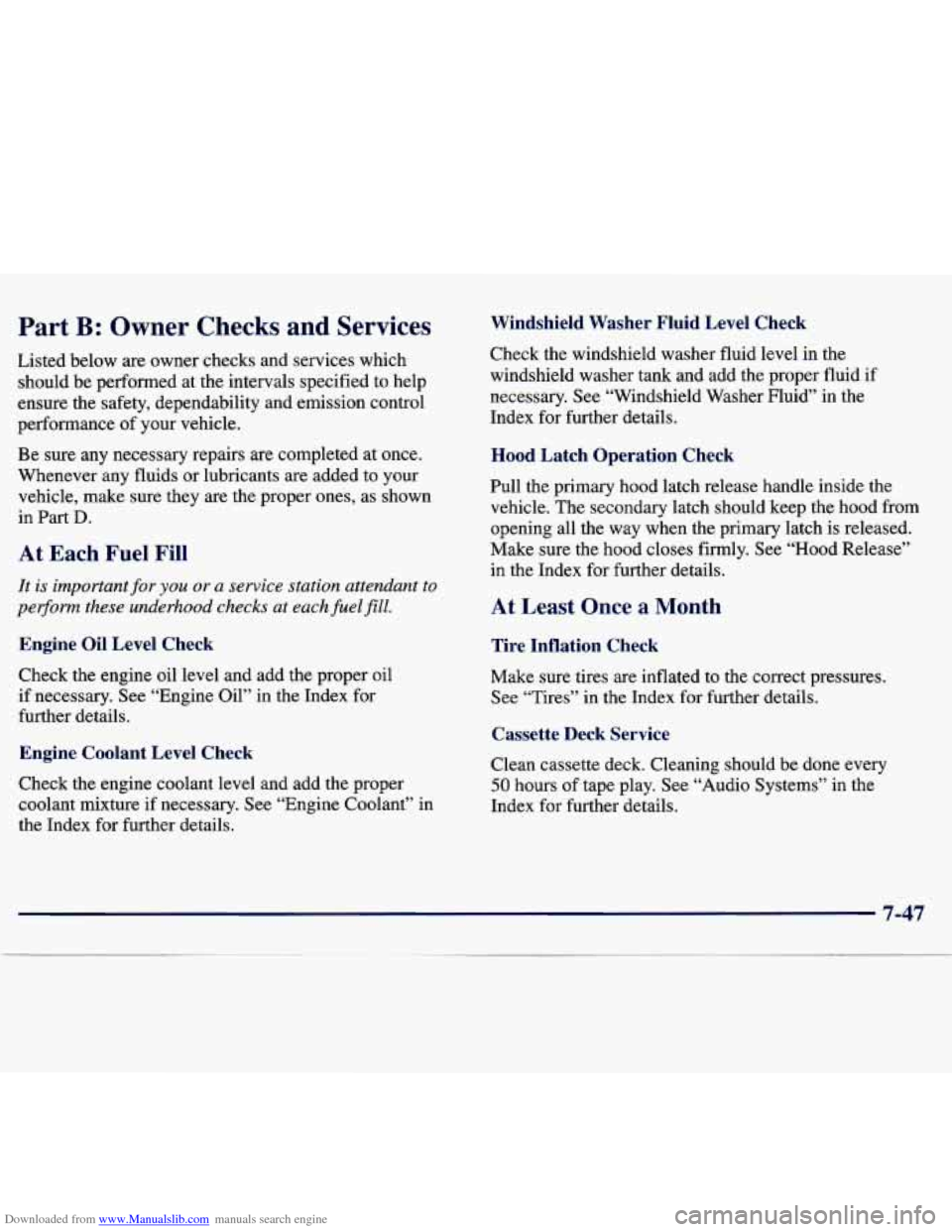
Downloaded from www.Manualslib.com manuals search engine Part B: Owner Checks and Services
Listed below are owner checks and services which should be performed at the intervals specified to help
ensure the safety, dependability and emission control
performance of your vehicle.
Be sure any necessary repairs are completed at once.
Whenever any fluids or lubricants are added to your
vehicle, make sure they are the proper ones, as shown
in
Part D.
At Each Fuel Fill
It is important for you or a service station attendant to
per3corm these underhood checks at eachfuelfill.
Engine Oil Level Check
Check the engine oil level and add the proper oil
if necessary. See “Engine Oil” in
the Index for
further details.
Engine Coolant Level Check
Check the engine coolant level and add the proper
coolant mixture if necessary. See “Engine Coolant” in
the Index for further details.
Windshield Washer Fluid Level Check
Check the windshield washer fluid level in the
windshield washer tank and add the proper fluid
if
necessary. See “Windshield Washer Fluid” in the
Index for further details.
Hood Latch Operation Check
Pull the primary hood latch release handle inside the
vehicle. The secondary latch should keep the hood from
opening all the way when the primary latch is released.
Make sure the hood closes firmly. See “Hood Release”
in the Index for further details.
At Least Once a Month
Tire Inflation Check
Make sure tires are inflated to the correct pressures.
See “Tires” in the Index for further details.
Cassette Deck Service
Clean cassette deck. Cleaning should be done every
50 hours of tape play. See “Audio Systems” in the
Index for further details.
7-47
Page 376 of 386

Downloaded from www.Manualslib.com manuals search engine Comfort Controls ................................ 3-2
Compact Disc Player
............................ 3- 11
Care
....................................... 3-17
Errors
...................................... 3-13
Control. Loss of
................................ 4-14
Control
of a Vehicle .............................. 4-6
Convertible Top
................................ 2-41
Convex Outside Mirror
.......................... 2-39
Coolant
....................................... 6-24
Levelcheck
................................. 5-15
Radiator
.................................... 5- 19
RecoveryTank ............................... 5-16
Temperature Gage
............................ 2-62
Cooling System
................................ 5-14
Courtesy Transportation
........................... 8-8
Cruise Control
................................. 2-33
Cupholders
.................................... 2-40
Customer Assistance for Text Telephone Users
......... 8-4
Customer Assistance Information
................... 8-1
Customer Satisfaction Procedure
.................... 8-2
Damage Finish
...................................... 6-55
SheetMetal
................................. 6-54
Daytime Running Lamps
......................... 2-37
Daytime Running Lamps Indicator Light
............ 2-67
DeadBattery
................................... 5-3
Defects. Reporting Safety
........................ 8-10
Defensive Driving
............................... 4-2
Defogger. Rear Window
.......................... 3-5 Defogging
..................................... 3-5
Defrosting
..................................... 3-5
Dimensions. Vehicle
............................ 6-63
Dome Lamp Bulb Replacement
.................... 6-40
Dome Lamps
.................................. 2-38
Door Locks
....................................... 2-4
Storage
..................................... 2-39
Downshifting
.................................. 2-17
Drive Position. Automatic Transmission
............. 2-13
DriverPosition
................................. 1-18
Driving
City
........................................ 4-34
Defensive
.................................... 4-2
Drunken
..................................... 4-3
Freeway
.................................... 4-35
Guidelines
.................................. 4-15
InaBlizzard
................................. 4-41
In Foreign Countries
........................... 6-5
IntheRain
.................................. 4-31
Night
...................................... 4-29
Off-Road
................................... 4-15
OnCurves .................................. 4-10
On Grades While Towing a Trailer
............... 4-54
On Hill and Mountain Roads
.................... 4-37
OnSnowandIce
............................. 4-39
Throughwater
............................... 4-33
WetRoads
.................................. 4-31
Winter
...................................... 4-39
WithaTrailer
................................ 4-52
Drunken Driving
................................ 4-3
9-3
. .- ............... ... ........................ .C.-..Y..YIY ..-Fli-..-.--.- .__ ....- - .. - .- -